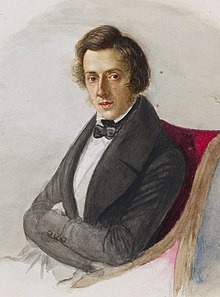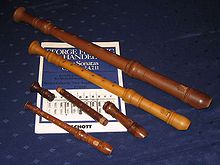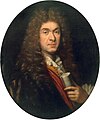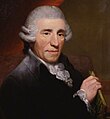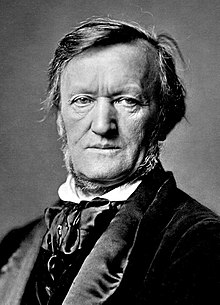Portal:Classical music
Portal maintenance status: (June 2018)
|
The Classical Music Portal


Classical music generally refers to the art music of the Western world, considered to be distinct from Western folk music or popular music traditions. It is sometimes distinguished as Western classical music, as the term "classical music" can also be applied to non-Western art musics. Classical music is often characterized by formality and complexity in its musical form and harmonic organization, particularly with the use of polyphony. Since at least the ninth century it has been primarily a written tradition, spawning a sophisticated notational system, as well as accompanying literature in analytical, critical, historiographical, musicological and philosophical practices. A foundational component of Western culture, classical music is frequently seen from the perspective of individual or groups of composers, whose compositions, personalities and beliefs have fundamentally shaped its history. (Full article...)
Selected articles - load new batch
-
Image 1Watercolour of Chopin by Maria Wodzińska, 1836
The Piano Sonata No. 2 in B♭ minor, Op. 35, is a piano sonata in four movements by Polish composer Frédéric Chopin. Chopin completed the work while living in George Sand's manor in Nohant, some 250 km (160 mi) south of Paris, a year before it was published in 1840. The first of the composer's three mature sonatas (the others being the Piano Sonata No. 3 in B minor, Op. 58 and the Sonata for Piano and Cello in G minor, Op. 65), the work is considered to be one of the greatest piano sonatas of the literature.
The third movement of the Piano Sonata No. 2 is Chopin's famous funeral march (French: Marche funèbre; Polish: Marsz żałobny) which was composed at least two years before the remainder of the work and has remained, by itself, one of Chopin's most popular compositions. The Piano Sonata No. 2 carries allusions and reminiscences of music by J. S. Bach and by Ludwig van Beethoven; Beethoven's Piano Sonata No. 12 also has a funeral march as its third movement. A typical performance of Chopin's second sonata lasts between 21 and 25 minutes, depending on whether the repetition of the first movement's exposition is observed. (Full article...) -
Image 2The Nutcracker (Russian: Щелкунчик, romanized: Shchelkunchik, pronounced [ɕːɪɫˈkunʲt͡ɕɪk] ⓘ), Op. 71, is an 1892 two-act classical ballet (conceived as a ballet-féerie; Russian: балет-феерия, romanized: balet-feyeriya) by Pyotr Ilyich Tchaikovsky, set on Christmas Eve at the foot of a Christmas tree in a child's imagination. The plot is an adaptation of Alexandre Dumas' 1844 short story The Nutcracker, itself a retelling of E. T. A. Hoffmann's 1816 short story The Nutcracker and the Mouse King. The ballet's first choreographer was Marius Petipa, with whom Tchaikovsky had worked three years earlier on The Sleeping Beauty, assisted by Lev Ivanov. Although the complete and staged The Nutcracker ballet was not initially as successful as the 20-minute Nutcracker Suite that Tchaikovsky had premiered nine months earlier, it became popular in later years.
Since the late 1960s, The Nutcracker has been danced by many ballet companies, especially in North America. Major American ballet companies generate around 40% of their annual ticket revenues from performances of the ballet. Its score has been used in several film adaptations of Hoffmann's story. (Full article...) -
Image 3

Portrait of Haydn by Thomas Hardy, c. 1791
Franz Joseph Haydn (/ˈhaɪdən/ HY-dən; German: [ˈfʁants ˈjoːzɛf ˈhaɪdn̩] ⓘ; 31 March 1732 – 31 May 1809) was an Austrian composer of the Classical period. He was instrumental in the development of chamber music such as the string quartet and piano trio. His contributions to musical form have led him to be called "Father of the Symphony" and "Father of the String quartet".
Haydn spent much of his career as a court musician for the wealthy Esterházy family at their Eszterháza Castle. Until the later part of his life, this isolated him from other composers and trends in music so that he was, as he put it, "forced to become original". Yet his music circulated widely, and for much of his career he was the most celebrated composer in Europe. (Full article...) -
Image 4

Macbeth at the Savonlinna Opera Festival in St. Olaf's Castle, Savonlinna, Finland, in 2007
Opera is a form of Western theatre in which music is a fundamental component and dramatic roles are taken by singers. Such a "work" (the literal translation of the Italian word "opera") is typically a collaboration between a composer and a librettist and incorporates a number of the performing arts, such as acting, scenery, costume, and sometimes dance or ballet. The performance is typically given in an opera house, accompanied by an orchestra or smaller musical ensemble, which since the early 19th century has been led by a conductor. Although musical theatre is closely related to opera, the two are considered to be distinct from one another.
Opera is a key part of Western classical music, and Italian tradition in particular. Originally understood as an entirely sung piece, in contrast to a play with songs, opera has come to include, including some that include spoken dialogue such as Singspiel and Opéra comique. In traditional number opera, singers employ two styles of singing: recitative, a speech-inflected style, and self-contained arias. The 19th century saw the rise of the continuous music drama. (Full article...) -
Image 5

Portrait by Anton Depauly, of Schubert at the end of his life
Franz Schubert's last three piano sonatas, D 958, 959 and 960, are his last major compositions for solo piano. They were written during the last months of his life, between the spring and autumn of 1828, but were not published until about ten years after his death, in 1838–39. Like the rest of Schubert's piano sonatas, they were mostly neglected in the 19th century. By the late 20th century, however, public and critical opinion had changed, and these sonatas are now considered among the most important of the composer's mature masterpieces. They are part of the core piano repertoire, appearing regularly on concert programs and recordings.
One of the reasons for the long period of neglect of Schubert's piano sonatas seems to be their dismissal as structurally and dramatically inferior to the sonatas of Beethoven. In fact, the last sonatas contain distinct allusions and similarities to works by Beethoven, a composer Schubert venerated. Nevertheless, musicological analysis has shown that they maintain a mature, individual style. The last sonatas are now praised for that mature style, manifested in unique features such as a cyclical formal and tonal design, chamber music textures, and a rare depth of emotional expression. (Full article...) -
Image 6
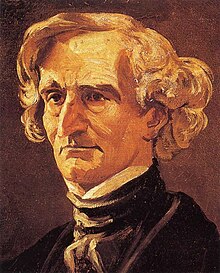
Hector Berlioz was the first to use the term "choral symphony" for a musical composition—his Roméo et Juliette.
A choral symphony is a musical composition for orchestra, choir, and sometimes solo vocalists that, in its internal workings and overall musical architecture, adheres broadly to symphonic musical form. The term "choral symphony" in this context was coined by Hector Berlioz when he described his Roméo et Juliette as such in his five-paragraph introduction to that work. The direct antecedent for the choral symphony is Ludwig van Beethoven's Ninth Symphony. Beethoven's Ninth incorporates part of the ode An die Freude ("Ode to Joy"), a poem by Friedrich Schiller, with text sung by soloists and chorus in the last movement. It is the first example of a major composer's use of the human voice on the same level as instruments in a symphony.
A few 19th-century composers, notably Felix Mendelssohn and Franz Liszt, followed Beethoven in producing choral symphonic works. Notable works in the genre were produced in the 20th century by Gustav Mahler, Igor Stravinsky, Ralph Vaughan Williams, Benjamin Britten and Dmitri Shostakovich, among others. The final years of the 20th century and the opening of the 21st century have seen several new works in this genre, among them compositions by Mikis Theodorakis, Peter Maxwell Davies, Tan Dun, Philip Glass, Hans Werner Henze, Krzysztof Penderecki, William Bolcom and Robert Strassburg. (Full article...) -
Image 7Cover of the symphony, with the dedication to Prince J. F. M. Lobkowitz and Count Rasumovsky
The Symphony No. 5 in C minor, Op. 67, also known as the Fate Symphony (German: Schicksalssinfonie), is a symphony composed by Ludwig van Beethoven between 1804 and 1808. It is one of the best-known compositions in classical music and one of the most frequently played symphonies, and it is widely considered one of the cornerstones of western music. First performed in Vienna's Theater an der Wien in 1808, the work achieved its prodigious reputation soon afterward. E. T. A. Hoffmann described the symphony as "one of the most important works of the time". As is typical of symphonies during the Classical period, Beethoven's Fifth Symphony has four movements.
It begins with a distinctive four-note "short-short-short-long" motif, often characterized as "fate knocking at the door", the Schicksals-Motiv (fate motif): (Full article...) -
Image 8
The recorder is a family of woodwind musical instruments in the group known as internal duct flutes: flutes with a whistle mouthpiece, also known as fipple flutes, although this is an archaic term. A recorder can be distinguished from other duct flutes by the presence of a thumb-hole for the upper hand and seven finger-holes: three for the upper hand and four for the lower. It is the most prominent duct flute in the western classical tradition.
Recorders are made in various sizes with names and compasses roughly corresponding to various vocal ranges. The sizes most commonly in use today are the soprano (also known as descant, lowest note C5), alto (also known as treble, lowest note F4), tenor (lowest note C4), and bass (lowest note F3). Recorders were traditionally constructed from wood or ivory. Modern professional instruments are almost invariably of wood, often boxwood; student and scholastic recorders are commonly of moulded plastic. The recorders' internal and external proportions vary, but the bore is generally reverse conical (i.e. tapering towards the foot) to cylindrical, and all recorder fingering systems make extensive use of forked fingerings. (Full article...) -
Image 9
Antonín Leopold Dvořák (/d(ə)ˈvɔːrʒɑːk, -ʒæk/ d(ə-)VOR-zha(h)k; Czech: [ˈantoɲiːn ˈlɛopold ˈdvor̝aːk] ⓘ; 8 September 1841 – 1 May 1904) was a Czech composer. He frequently employed rhythms and other aspects of the folk music of Moravia and his native Bohemia, following the Romantic-era nationalist example of his predecessor Bedřich Smetana. Dvořák's style has been described as "the fullest recreation of a national idiom with that of the symphonic tradition, absorbing folk influences and finding effective ways of using them," and Dvořák has been described as "arguably the most versatile... composer of his time".
Dvořák displayed his musical gifts at an early age, being a talented violin student. The first public performances of his works were in Prague in 1872 and, with special success, in 1873, when he was 31 years old. Seeking recognition beyond the Prague area, he submitted scores of symphonies and other works to German and Austrian competitions. He did not win a prize until 1874, with Johannes Brahms on the jury of the Austrian State Competition. In 1877, after his third win, Brahms recommended Dvořák to his publisher, Simrock, who commissioned what became the Slavonic Dances, Op. 46. The sheet music's high sales and critical reception led to his international success. A London performance of Dvořák's Stabat Mater in 1883 led to many other performances in the United Kingdom, the United States, and eventually Russia in March 1890. The Seventh Symphony was written for London in 1885. (Full article...) -
Image 10
La traviata (Italian: [la traviˈaːta, -aˈvjaː-]; The Fallen Woman) is an opera in three acts by Giuseppe Verdi set to an Italian libretto by Francesco Maria Piave. It is based on La Dame aux camélias (1852), a play by Alexandre Dumas fils, which he adapted from his own 1848 novel. The opera was originally titled Violetta, after the main character. It was first performed on 6 March 1853 at La Fenice opera house in Venice.
Piave and Verdi wanted to follow Dumas in giving the opera a contemporary setting, but the authorities at La Fenice insisted that it be set in the past, "c. 1700". It was not until the 1880s that the composer's and librettist's original wishes were carried out and "realistic" productions were staged. La traviata has become immensely popular and is among the most frequently performed of all operas. (Full article...) -
Image 11Ida Rubinstein, who commissioned Boléro, in 1922
Boléro is a 1928 work for large orchestra by French composer Maurice Ravel. It is one of Ravel's most famous compositions. It was also one of his last completed works before illness diminished his ability to write music. (Full article...) -
Image 12
Carmen (French: [kaʁmɛn] ⓘ) is an opera in four acts by the French composer Georges Bizet. The libretto was written by Henri Meilhac and Ludovic Halévy, based on the novella of the same title by Prosper Mérimée. The opera was first performed by the Opéra-Comique in Paris on 3 March 1875, where its breaking of conventions shocked and scandalised its first audiences. Bizet died suddenly after the 33rd performance, unaware that the work would achieve international acclaim within the following ten years. Carmen has since become one of the most popular and frequently performed operas in the classical canon; the "Habanera" and "Seguidilla" from act 1 and the "Toreador Song" from act 2 are among the best known of all operatic arias.
The opera is written in the genre of opéra comique with musical numbers separated by dialogue. It is set in southern Spain and tells the story of the downfall of Don José, a naïve soldier who is seduced by the wiles of the fiery gypsy Carmen. José abandons his childhood sweetheart and deserts from his military duties, yet loses Carmen's love to the glamorous torero Escamillo, after which José kills her in a jealous rage. The depictions of proletarian life, immorality, and lawlessness, and the tragic death of the main character on stage, broke new ground in French opera and were highly controversial. (Full article...)
General images - load new batch
-
Image 2The opening bars of the Commendatore's aria in Mozart's opera Don Giovanni. The orchestra starts with a dissonant diminished seventh chord (G# dim7 with a B in the bass) moving to a dominant seventh chord (A7 with a C# in the bass) before resolving to the tonic chord (D minor) at the singer's entrance. (from Classical period (music))
-
Image 3A large instrumental ensemble's performance in the lavish Teatro Argentina, as depicted by Panini (1747) (from Baroque music)
-
Image 51875 oil painting of Franz Schubert by Wilhelm August Rieder, after his own 1825 watercolor portrait (from Classical period (music))
-
Image 6Double-manual harpsichord by Vital Julian Frey, after Jean-Claude Goujon (1749) (from Baroque music)
-
Image 7Bernhard Crusell, a Swedish-Finnish composer and clarinetist, in 1826 (from Classical period (music))
-
Image 8Wanderer above the Sea of Fog, by Caspar David Friedrich, is an example of Romantic painting. (from Romantic music)
-
Image 9Fortepiano by Paul McNulty after Walter & Sohn, c. 1805 (from Classical period (music))
-
Image 11Musicians from 'Procession in honour of Our Lady of Sablon in Brussels.' Early 17th-century Flemish alta cappella. From left to right: bass dulcian, alto shawm, treble cornett, soprano shawm, alto shawm, tenor sackbut. (from Renaissance music)
-
Image 12The Mozart family c. 1780. The portrait on the wall is of Mozart's mother. (from Classical period (music))
-
Image 14Gerard van Honthorst, The Concert (1623), National Gallery of Art, Washington D.C. (from Renaissance music)
-
Image 16Josef Danhauser's 1840 painting of Franz Liszt at the piano surrounded by (from left to right) Alexandre Dumas, Hector Berlioz, George Sand, Niccolò Paganini, Gioachino Rossini and Marie d'Agoult, with a bust of Ludwig van Beethoven on the piano (from Romantic music)
-
Image 17Richard Wagner in Paris, 1861
-
Image 20Portion of Du Fay's setting of Ave maris stella, in fauxbourdon. The top line is a paraphrase of the chant; the middle line, designated "fauxbourdon", (not written) follows the top line but exactly a perfect fourth below. The bottom line is often, but not always, a sixth below the top line; it is embellished, and reaches cadences on the octave.Play (from Renaissance music)
-
Image 23Painting by Evaristo Baschenis of Baroque instruments, including a cittern, viola da gamba, violin, and two lutes (from Baroque music)
-
Image 24Wolfgang Amadeus Mozart, posthumous painting by Barbara Krafft in 1819 (from Classical period (music))
-
Image 25Gustav Mahler, photographed in 1907 by Moritz Nähr at the end of his period as director of the Vienna Hofoper (from Romantic music)
-
Image 27Marc-Antoine Charpentier (from Baroque music)
-
Image 28A young Wolfgang Amadeus Mozart, a representative composer of the Classical period, seated at a keyboard. (from Classical period (music))
-
Image 30Individual sheet music for a seventeenth-century harp. (from Baroque music)
-
Image 32Balakirev (top), Cui (upper left), Mussorgsky (upper right), Rimsky-Korsakov (lower left), and Borodin (lower right). (from Romantic music)
-
Image 34A modern string quartet. In the 2000s, string quartets from the Classical era are the core of the chamber music literature. From left to right: violin 1, violin 2, cello, viola (from Classical period (music))
-
Image 35Hummel in 1814 (from Classical period (music))
-
Image 37Gluck, detail of a portrait by Joseph Duplessis, dated 1775 (Kunsthistorisches Museum, Vienna) (from Classical period (music))
Quotes - show another
| “ | Music, moody food of us that trade in love. | ” |
| — William Shakespeare | ||
Related portals
WikiProjects
 Selected composers - load new batch
Selected composers - load new batch 
-
Image 1
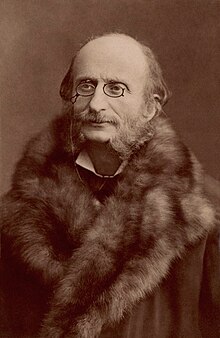
Offenbach by Nadar
Jacques Offenbach (/ˈɒfənbɑːx/; 20 June 1819 – 5 October 1880) was a German-born French composer, cellist and impresario. He is remembered for his nearly 100 operettas of the 1850s to the 1870s, and his uncompleted opera The Tales of Hoffmann. He was a powerful influence on later composers of the operetta genre, particularly Franz von Suppé, Johann Strauss II and Arthur Sullivan. His best-known works were continually revived during the 20th century, and many of his operettas continue to be staged in the 21st. The Tales of Hoffmann remains part of the standard opera repertory.
Born in Cologne, Kingdom of Prussia, the son of a synagogue cantor, Offenbach showed early musical talent. At the age of 14, he was accepted as a student at the Paris Conservatoire; he found academic study unfulfilling and left after a year, but remained in Paris. From 1835 to 1855 he earned his living as a cellist, achieving international fame, and as a conductor. His ambition, however, was to compose comic pieces for the musical theatre. Finding the management of Paris's Opéra-Comique company uninterested in staging his works, in 1855 he leased a small theatre in the Champs-Élysées. There, during the next three years, he presented a series of more than two dozen of his own small-scale pieces, many of which became popular. (Full article...) -
Image 2
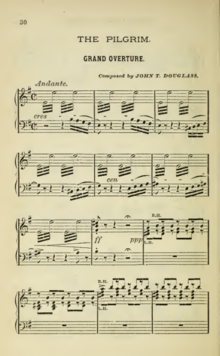
First page of The Pilgrim: Grand Overture by Douglass
John Thomas Douglass (1847–1886) was an American composer, virtuoso violinist, conductor and teacher. He is best known for composing Virginia's Ball (1868), which is generally regarded as the first opera written by a Black American composer. The work is now lost, and his only extant composition is The Pilgrim: Grand Overture (1878) for piano. His biography from James Monroe Trotter's Music and Some Highly Musical People (1878)—in which The Pilgrim survives—reports that he wrote many now lost pieces for piano, orchestra and particularly guitar, which he was known to play.
A highly regarded violinist, Douglass's violin playing received high praise during his lifetime. In addition to his solo career, he traveled with various groups throughout the 1870s, including the Hyers Sisters. He settled in New York by the 1880s and conducted both a music studio and string ensemble. Later in life he led a teaching studio, and among his students was David Mannes who became the concertmaster of the New York Symphony Orchestra. Nearly 30 years after Douglass's death at age 38–39, Mannes founded the Colored Music Settlement School in the memory of his teacher. (Full article...) -
Image 3

Mykola Leontovych
Mykola Dmytrovych Leontovych (Ukrainian: Микола Дмитрович Леонтович, pronounced [mɪˈkɔlɐ dmɪˈtrɔʋet͡ʃ ɫeɔnˈtɔʋet͡ʃ] ⓘ; 13 December [O.S. 1 December] 1877 – 23 January 1921) was a Ukrainian composer, conductor, ethnomusicologist, and teacher. His music was inspired by the Ukrainian composer Mykola Lysenko and the Ukrainian National Music School. Leontovych specialised in a cappella choral music, ranging from original compositions to church music to elaborate arrangements of folk music.
Leontovych was born and raised in Monastyrok in the Podolia province of the Russian Empire (now in Vinnytsia Oblast, Western Ukraine). He was educated as a priest in the Kamianets-Podilskyi Theological Seminary. With the independence of the Ukrainian State in the 1917 revolution, he moved to Kyiv, where he worked at the Kyiv Conservatory and the Mykola Lysenko Institute of Music and Drama. He composed "Shchedryk" in 1914 (premiered in 1916), now known to the English-speaking world as "Carol of the Bells". He was murdered by a Soviet agent in 1921 and is known as a martyr in the Eastern Orthodox Ukrainian Church, where he is also remembered for his liturgy, the first composed in the vernacular, specifically in the modern Ukrainian language. (Full article...) -
Image 4Sir Michael Kemp Tippett CH CBE (2 January 1905 – 8 January 1998) was an English composer who rose to prominence during and immediately after the Second World War. In his lifetime he was sometimes ranked with his contemporary Benjamin Britten as one of the leading British composers of the 20th century. Among his best-known works are the oratorio A Child of Our Time, the orchestral Fantasia Concertante on a Theme of Corelli, and the opera The Midsummer Marriage.
Tippett's talent developed slowly. He withdrew or destroyed his earliest compositions, and was 30 before any of his works were published. Until the mid-to-late 1950s his music was broadly lyrical in character, before changing to a more astringent and experimental style. New influences—including those of jazz and blues after his first visit to America in 1965—became increasingly evident in his compositions. While Tippett's stature with the public continued to grow, not all critics approved of these changes in style, some believing that the quality of his work suffered as a consequence. From around 1976 his late works began to reflect the works of his youth through a return to lyricism. Although he was much honoured in his lifetime, critical judgement on Tippett's legacy has been uneven, the greatest praise generally reserved for his earlier works. His centenary in 2005 was a muted affair; apart from the few best-known works, his music has not been performed frequently in the 21st century. (Full article...) -
Image 5Jane Marian Joseph (31 May 1894 – 9 March 1929) was an English composer, arranger and music teacher. She was a pupil and later associate of the composer Gustav Holst, and was instrumental in the organisation and management of various of the music festivals which Holst sponsored. Many of her works were composed for performance at these festivals and similar occasions. Her early death at age 35, which prevented the full realisation of her talents, was considered by her contemporaries as a considerable loss to English music.
Holst first observed Joseph's potential when he was teaching her composition at St Paul's Girls' School. She began to act as his amanuensis in 1914, when he was composing The Planets, her special responsibility being the preparation of the score for the "Neptune" movement. She continued to assist Holst with transcriptions, arrangements and translations, and was his librettist for the choral ballet The Golden Goose. (Full article...) -
Image 6
Frédéric François Chopin (born Fryderyk Franciszek Chopin; 1 March 1810 – 17 October 1849) was a Polish composer and virtuoso pianist of the Romantic period, who wrote primarily for solo piano. He has maintained worldwide renown as a leading musician of his era, one whose "poetic genius was based on a professional technique that was without equal in his generation".
Chopin was born in Żelazowa Wola and grew up in Warsaw, which in 1815 became part of Congress Poland. A child prodigy, he completed his musical education and composed his earlier works in Warsaw before leaving Poland at the age of 20, less than a month before the outbreak of the November 1830 Uprising. At 21, he settled in Paris. Thereafter he gave only 30 public performances, preferring the more intimate atmosphere of the salon. He supported himself by selling his compositions and by giving piano lessons, for which he was in high demand. Chopin formed a friendship with Franz Liszt and was admired by many of his musical contemporaries, including Robert Schumann. After a failed engagement to Maria Wodzińska from 1836 to 1837, he maintained an often troubled relationship with the French writer Aurore Dupin (known by her pen name George Sand). A brief and unhappy visit to Mallorca with Sand in 1838–39 would prove one of his most productive periods of composition. In his final years, he was supported financially by his admirer Jane Stirling. For most of his life, Chopin was in poor health. He died in Paris in 1849 at the age of 39. (Full article...) -
Image 7
Sergei Sergeyevich Prokofiev (27 April [O.S. 15 April] 1891 – 5 March 1953) was a Russian composer, pianist, and conductor who later worked in the Soviet Union. As the creator of acknowledged masterpieces across numerous music genres, he is regarded as one of the major composers of the 20th century. His works include such widely heard pieces as the March from The Love for Three Oranges, the suite Lieutenant Kijé, the ballet Romeo and Juliet—from which "Dance of the Knights" is taken—and Peter and the Wolf. Of the established forms and genres in which he worked, he created—excluding juvenilia—seven completed operas, seven symphonies, eight ballets, five piano concertos, two violin concertos, a cello concerto, a symphony-concerto for cello and orchestra, and nine completed piano sonatas.
A graduate of the Saint Petersburg Conservatory, Prokofiev initially made his name as an iconoclastic composer-pianist, achieving notoriety with a series of ferociously dissonant and virtuosic works for his instrument, including his first two piano concertos. In 1915, Prokofiev made a decisive break from the standard composer-pianist category with his orchestral Scythian Suite, compiled from music originally composed for a ballet commissioned by Sergei Diaghilev of the Ballets Russes. Diaghilev commissioned three further ballets from Prokofiev—Chout, Le pas d'acier and The Prodigal Son—which, at the time of their original production, all caused a sensation among both critics and colleagues. But Prokofiev's greatest interest was opera, and he composed several works in that genre, including The Gambler and The Fiery Angel. Prokofiev's one operatic success during his lifetime was The Love for Three Oranges, composed for the Chicago Opera and performed over the following decade in Europe and Russia. (Full article...) -
Image 8
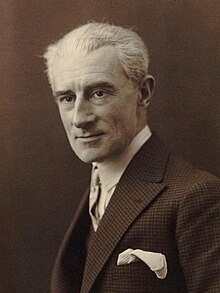
Ravel in 1925
Joseph Maurice Ravel (7 March 1875 – 28 December 1937) was a French composer, pianist and conductor. He is often associated with Impressionism along with his elder contemporary Claude Debussy, although both composers rejected the term. In the 1920s and 1930s Ravel was internationally regarded as France's greatest living composer.
Born to a music-loving family, Ravel attended France's premier music college, the Paris Conservatoire; he was not well regarded by its conservative establishment, whose biased treatment of him caused a scandal. After leaving the conservatoire, Ravel found his own way as a composer, developing a style of great clarity and incorporating elements of modernism, baroque, neoclassicism and, in his later works, jazz. He liked to experiment with musical form, as in his best-known work, Boléro (1928), in which repetition takes the place of development. Renowned for his abilities in orchestration, Ravel made some orchestral arrangements of other composers' piano music, of which his 1922 version of Mussorgsky's Pictures at an Exhibition is the best known. (Full article...) -
Image 9Wall at a Video Games Live event in 2009
Jack Wall (born 1964) is an American video game music composer. He has worked on video game music for over 20 games including the Myst franchise, Splinter Cell, Jade Empire, Mass Effect, and Call of Duty. Wall earned a degree in civil engineering from Drexel University in Philadelphia, Pennsylvania, and, after a brief stint working in civil engineering, transitioned into music production. He worked with musicians such as John Cale, David Byrne, and Patti Smith, and, after performing increasingly complex production and sound engineering tasks, moved into music composition in 1995.
Wall immediately began working in the video game industry, composing the soundtrack to Vigilance. Primarily composing in an orchestral style, by 2001 he composed the soundtrack to Myst III: Exile, which was the title he says put him on the map as a video game composer. In 2002, Wall became one of around 20 co-founders of the Game Audio Network Guild (G.A.N.G.) as well as senior director. In 2005, Wall, along with G.A.N.G. founder and fellow composer Tommy Tallarico, produced the Video Games Live concert series, having served as the conductor for the international concert tour. His soundtracks for Myst III: Exile, Myst IV: Revelation, Rise of the Kasai, Jade Empire, Mass Effect, and Mass Effect 2 were nominated for and won multiple awards. (Full article...) -
Image 10
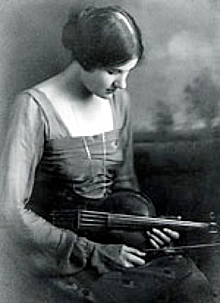
Clarke with a viola in 1919
Rebecca Helferich Clarke (27 August 1886 – 13 October 1979) was a British classical composer and violist. Internationally renowned as a viola virtuoso, she also became one of the first female professional orchestral players in London.
Rebecca Clarke had German and American parents, and spent substantial periods of her life in the United States, where she permanently settled after World War II. She was born in Harrow and studied at the Royal Academy of Music and Royal College of Music in London. Stranded in the United States at the outbreak of World War II, she married composer and pianist James Friskin in 1944. Clarke died at her home in New York at the age of 93. (Full article...) -
Image 11
Leo Ornstein (born Лев Орнштейн, Lev Ornshteyn; c. December 11, 1895 – February 24, 2002) was an American experimental composer and pianist of the early twentieth century. His performances of works by avant-garde composers and his own innovative and even shocking pieces made him a cause célèbre on both sides of the Atlantic. The bulk of his experimental works were written for piano.
Ornstein was the first important composer to make extensive use of the tone cluster. As a pianist, he was considered a world-class talent. By the mid-1920s, he had walked away from his fame and soon disappeared from popular memory. Though he gave his last public concert before the age of forty, he continued writing music for another half-century and beyond. Largely forgotten for decades, he was rediscovered in the mid-1970s. Ornstein completed his eighth and final piano sonata in September 1990 at the age of ninety-four, making him the oldest published composer in history at the time (a mark since passed by Elliott Carter). (Full article...) -
Image 12
Wilhelm Richard Wagner (/ˈvɑːɡnər/ VAHG-nər; German: [ˈʁɪçaʁt ˈvaːɡnɐ] ⓘ; 22 May 1813 – 13 February 1883) was a German composer, theatre director, essayist, and conductor who is chiefly known for his operas (or, as some of his mature works were later known, "music dramas"). Unlike most opera composers, Wagner wrote both the libretto and the music for each of his stage works. Initially establishing his reputation as a composer of works in the romantic vein of Carl Maria von Weber and Giacomo Meyerbeer, Wagner revolutionised opera through his concept of the Gesamtkunstwerk ("total work of art"), by which he sought to synthesise the poetic, visual, musical and dramatic arts, with music subsidiary to drama. The drama was to be presented as a continuously sung narrative, without conventional operatic structures like arias and recitatives. He described this vision in a series of essays published between 1849 and 1852. Wagner realised these ideas most fully in the first half of the 16-hour, four-opera cycle Der Ring des Nibelungen (The Ring of the Nibelung, also known simply as The Ring).
Wagner's compositions, particularly those of his later period, are notable for their complex textures, rich harmonies and orchestration, and the elaborate use of leitmotifs—musical phrases associated with individual characters, places, ideas, or plot elements. His advances in musical language, such as extreme chromaticism and quickly shifting tonal centres, greatly influenced the development of classical music; his Tristan und Isolde is sometimes described as marking the start of modern music. As he matured, he softened his ideological stance against traditional operatic forms (ie. arias, ensembles and choruses), reintroducing them into his last few stage works, including Die Meistersinger von Nürnberg (The Mastersingers of Nuremberg) and Parsifal. (Full article...) -
Image 13

Portrait of Mozart, aged 13, in Verona, 1770, attributed to Giambettino Cignaroli
Between 1769 and 1773, the young Wolfgang Amadeus Mozart and his father Leopold Mozart made three Italian journeys. The first, an extended tour of 15 months, was financed by performances for the nobility and by public concerts, and took in the most important Italian cities. The second and third journeys were to Milan, for Wolfgang to complete operas that had been commissioned there on the first visit. From the perspective of Wolfgang's musical development the journeys were a considerable success, and his talents were recognised by honours which included a papal knighthood and memberships in leading philharmonic societies.
Leopold Mozart had been employed since 1747 as a musician in the Archbishop of Salzburg's court, becoming deputy Kapellmeister in 1763, but he had also devoted much time to Wolfgang's and sister Nannerl's musical education. He took them on a European tour between 1763 and 1766, and spent some of 1767 and most of 1768 with them in the imperial capital, Vienna. The children's performances had captivated audiences, and the pair had made a considerable impression on European society. By 1769, Nannerl had reached adulthood, but Leopold was anxious to continue 13-year-old Wolfgang's education in Italy, a crucially important destination for any rising composer of the 18th century. (Full article...) -
Image 14

Vaughan Williams c. 1920
Ralph Vaughan Williams OM (/ˌreɪf vɔːn ˈwɪljəmz/ ⓘ RAYF vawn WIL-yəmz; 12 October 1872 – 26 August 1958) was an English composer. His works include operas, ballets, chamber music, secular and religious vocal pieces and orchestral compositions including nine symphonies, written over sixty years. Strongly influenced by Tudor music and English folk-song, his output marked a decisive break in British music from its German-dominated style of the 19th century.
Vaughan Williams was born to a well-to-do family with strong moral views and a progressive social outlook. Throughout his life he sought to be of service to his fellow citizens, and believed in making music as available as possible to everybody. He wrote many works for amateur and student performance. He was musically a late developer, not finding his true voice until his late thirties; his studies in 1907–1908 with the French composer Maurice Ravel helped him clarify the textures of his music and free it from Teutonic influences. (Full article...) -
Image 15Erik William Chisholm (4 January 1904 – 8 June 1965) was a Scottish composer, pianist, organist and conductor sometimes known as "Scotland's forgotten composer". According to his biographer, Chisholm "was the first composer to absorb Celtic idioms into his music in form as well as content, his achievement paralleling that of Bartók in its depth of understanding and its daring", which led some to give him the nickname "MacBartók". As composer, performer and impresario, he played an important role in the musical life of Glasgow between the two World Wars and was a founder of the Celtic Ballet and, together with Margaret Morris, created the first full-length Scottish ballet, The Forsaken Mermaid. After World War II he was Professor and Head of the South African College of Music at the University of Cape Town for 19 years until his death. Chisholm founded the South African College of Music opera company in Cape Town and was a vital force in bringing new operas to Scotland, England and South Africa. By the time of his death in 1965, he had composed over a hundred works. (Full article...)
Did you know (auto-generated) - load new batch

- ... that gas lighting inspired Stephen Gunzenhauser to start a classical music festival?
- ... that the choral music of Artemy Vedel, who is regarded as one of the Golden Three composers of 18th-century Ukrainian classical music, was censored but performed from handwritten copies?
- ... that opera singer Charles Holland spent much of his career in Europe as opportunities in classical music for African Americans were limited?
- ... that WFMT classical music radio host Don Tait owned such a large collection of recordings that he had to buy a house and have its floor reinforced to accommodate the weight?
- ... that in 1994, Anthony Pople created two computer programs to analyse classical music?
- ... that the Stadthalle Hannover, the largest classical music concert hall in Germany by capacity, was modelled after the Pantheon in Rome and completed by 1914?
Selected image
-
Image 1Painting: Thomas GainsboroughJohann Christian Bach (5 September 1735 – 1 January 1782) was a composer of the Classical era, the eighteenth child of Johann Sebastian Bach, and the youngest of his eleven sons. Bach was taught by his father and then, after the latter's death, by his half-brother C. P. E. Bach. Bach moved to Italy in 1754, and then to London in 1762, where he became known as the "London Bach". Bach's compositions include eleven operas, as well as chamber music, orchestral music and compositions for keyboard music. In 1764 Bach met Wolfgang Amadeus Mozart, who was eight at the time, and spent five months teaching him composition. He had considerable influence on Mozart, and was later described by scholars as his "only, true teacher".
This portrait of Bach was painted in 1776 by Thomas Gainsborough, as part of a collection started by Bach's former teacher Padre Martini. It now hangs in the National Portrait Gallery, London. -
Image 2
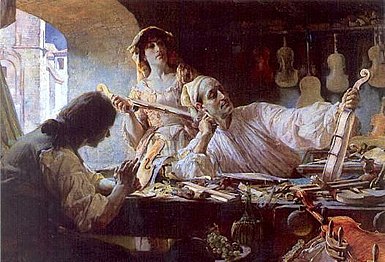 Stradivarius is one of the violins, violas, cellos and other string instruments built by members of the Italian Stradivari family, particularly Antonio Stradivari.
Stradivarius is one of the violins, violas, cellos and other string instruments built by members of the Italian Stradivari family, particularly Antonio Stradivari. -
Image 3Photo: W. J. Mayer; Restoration: Lise BroerA bust of the German composer and pianist Ludwig van Beethoven (1770–1827), made from his death mask. He was a crucial figure in the transitional period between the Classical and Romantic eras in Western classical music, and remains one of the most acclaimed and influential composers of all time. Born in Bonn, of the Electorate of Cologne and a part of the Holy Roman Empire of the German Nation in present-day Germany, he moved to Vienna in his early twenties and settled there, studying with Joseph Haydn and quickly gaining a reputation as a virtuoso pianist. His hearing began to deteriorate in the late 1790s, yet he continued to compose, conduct, and perform, even after becoming completely deaf.
-
Image 4
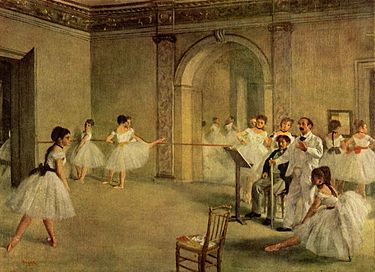 Ballet is a formalized form of dance with its origins in the French court, further developed in France and Russia as a concert dance form.
Ballet is a formalized form of dance with its origins in the French court, further developed in France and Russia as a concert dance form. -
Image 5Photo: Guillaume PiolleThe anatomy of a Périnet piston valve, this one taken from a B♭ trumpet. When depressed, the valve diverts the air stream through additional tubing, thus lengthening the instrument and lowering the harmonic series on which the instrument is vibrating (i.e., it lowers the pitch). Trumpets generally use three valves, with some variations, such as a piccolo trumpet, having four. When used singly or in combination, the valves make the instrument fully chromatic, or capable of playing all twelve pitches of classical music. Trumpets may also use rotary valves instead.
-
Image 6Photograph credit: Eugène Pirou; restored by Adam CuerdenJules Massenet (12 May 1842 – 13 August 1912) was a French composer of the Romantic era, best known for his operas. Between 1867 and his death, he wrote more than forty stage works in a wide variety of styles, from opéra comique to grand depictions of classical myths, romantic comedies and lyric dramas, as well as oratorios, cantatas and ballets. Massenet had a good sense of the theatre and of what would succeed with the Parisian public. Despite some miscalculations, he produced a series of successes that made him the leading opera composer in France in the late 19th and early 20th centuries. By the time of his death, he was regarded as old-fashioned; his works, however, began to be favourably reassessed during the mid-20th century, and many have since been staged and recorded. This photograph of Massenet was taken by French photographer Eugène Pirou in 1875.
-
Image 7
 The Teatro alla Scala (or La Scala, as it is known), in Milan, Italy, is one of the world's most famous opera houses. The theatre was inaugurated on 3 August 1778, under the name Nuovo Regio Ducal Teatro alla Scala with Salieri's Europa riconosciuta.
The Teatro alla Scala (or La Scala, as it is known), in Milan, Italy, is one of the world's most famous opera houses. The theatre was inaugurated on 3 August 1778, under the name Nuovo Regio Ducal Teatro alla Scala with Salieri's Europa riconosciuta. -
Image 8

A picture of the first theatre drawn shortly before it burned down in 1808.
The Royal Opera House is an opera house and major performing arts venue in the London district of Covent Garden. The large building, often referred to as simply "Covent Garden", is the home of The Royal Opera, The Royal Ballet and the Orchestra of the Royal Opera House. -
Image 9Photograph: David IliffThe Royal Albert Hall is a concert hall, seating a maximum of 5,272, on the northern edge of South Kensington, London. Constructed beginning in 1867, the hall was inaugurated on 29 March 1871. Since 1941 it has held The Proms, an eight-week summer season of daily orchestral classical music concerts and other events.
-
Image 10Sheet music for the Polonaise in A-flat major, Op. 53, a solo piano piece written by Frédéric Chopin in 1842. This work is one of Chopin's most admired compositions and has long been a favorite of the classical piano repertoire. The piece, which is very difficult, requires exceptional pianistic skills and great virtuosity to be interpreted. A typical performance of the polonaise lasts seven minutes.
-
Image 11Photograph credit: William P. Gottlieb; restored by Adam CuerdenBilly Strayhorn (November 29, 1915 – May 31, 1967) was an American jazz composer, pianist, lyricist, and arranger, best remembered for his long-time collaboration with bandleader and composer Duke Ellington that lasted nearly three decades. Though classical music was Strayhorn's first love, his ambition to become a classical composer went unrealized because of the harsh reality of a black man trying to make his way in the world of classical music, which at that time was almost completely white. He was introduced to the music of pianists like Art Tatum and Teddy Wilson at age 19, and the artistic influence of these musicians guided him into the realm of jazz, where he remained for the rest of his life. This photograph of Strayhorn was taken by William P. Gottlieb in the 1940s.
Topics
Things you can do
Associated Wikimedia
The following Wikimedia Foundation sister projects provide more on this subject:
-
Commons
Free media repository -
Wikibooks
Free textbooks and manuals -
Wikidata
Free knowledge base -
Wikinews
Free-content news -
Wikiquote
Collection of quotations -
Wikisource
Free-content library -
Wikiversity
Free learning tools -
Wiktionary
Dictionary and thesaurus
- Pages using the Phonos extension
- Pages with Russian IPA
- Pages including recorded pronunciations
- Pages with German IPA
- Pages with Czech IPA
- Pages with Italian IPA
- Pages with French IPA
- Pages with Ukrainian IPA
- Portals with triaged subpages from June 2018
- All portals with triaged subpages
- Portals with no named maintainer
- Automated article-slideshow portals with 51–100 articles in article list
- Random portal component with more available subpages than specified max
- Random portal component with 16–20 available subpages


